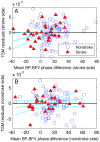Impaired cerebral autoregulation is associated with brain atrophy and worse functional status in chronic ischemic stroke
- PMID: 23071639
- PMCID: PMC3469603
- DOI: 10.1371/journal.pone.0046794
Impaired cerebral autoregulation is associated with brain atrophy and worse functional status in chronic ischemic stroke
Abstract
Dynamic cerebral autoregulation (dCA) is impaired following stroke. However, the relationship between dCA, brain atrophy, and functional outcomes following stroke remains unclear. In this study, we aimed to determine whether impairment of dCA is associated with atrophy in specific regions or globally, thereby affecting daily functions in stroke patients.We performed a retrospective analysis of 33 subjects with chronic infarctions in the middle cerebral artery territory, and 109 age-matched non-stroke subjects. dCA was assessed via the phase relationship between arterial blood pressure and cerebral blood flow velocity. Brain tissue volumes were quantified from MRI. Functional status was assessed by gait speed, instrumental activities of daily living (IADL), modified Rankin Scale, and NIH Stroke Score.Compared to the non-stroke group, stroke subjects showed degraded dCA bilaterally, and showed gray matter atrophy in the frontal, parietal and temporal lobes ipsilateral to infarct. In stroke subjects, better dCA was associated with less temporal lobe gray matter atrophy on the infracted side ([Formula: see text] = 0.029), faster gait speed ([Formula: see text] = 0.018) and lower IADL score ([Formula: see text]0.002). Our results indicate that better dynamic cerebral perfusion regulation is associated with less atrophy and better long-term functional status in older adults with chronic ischemic infarctions.
Conflict of interest statement
Figures

 ). Regression included age, BMI, mean BP, sex and infarct volume for stroke side of the stroke group plotted against blood pressure-blood flow velocity (BP-BFV) phase difference for stroke (A) and non-stroke (B) sides. Cyan lines indicate least squares regression line for BP-BFV phase difference on temporal GM residuals in stroke subjects, and 95% prediction interval.
). Regression included age, BMI, mean BP, sex and infarct volume for stroke side of the stroke group plotted against blood pressure-blood flow velocity (BP-BFV) phase difference for stroke (A) and non-stroke (B) sides. Cyan lines indicate least squares regression line for BP-BFV phase difference on temporal GM residuals in stroke subjects, and 95% prediction interval.
References
-
- Lassen N (1959) Cerebral blood ow and oxygen consumption in man. Physiol Rev 39: 183–238. - PubMed
-
- Paulson O, Strandgaard S, Edvinsson L (1990) Cerebral autoregulation. Cerebrovasc Brain Metab Rev 2: 161–192. - PubMed
-
- Reinhard M, Wihler C, Roth M, Harloff A, Niesen W, et al. (2008) Cerebral autoregulation dynamics in acute ischemic stroke after rtPA thrombolysis. Cerebrovasc Dis 26: 147–155. - PubMed
Publication types
MeSH terms
Grants and funding
- 1P30AG028717-01A2/AG/NIA NIH HHS/United States
- R01-NS045745/NS/NINDS NIH HHS/United States
- P30AG028717/AG/NIA NIH HHS/United States
- R00HL102241/HL/NHLBI NIH HHS/United States
- K99HL102241/HL/NHLBI NIH HHS/United States
- 1R41NS053128-01A2/NS/NINDS NIH HHS/United States
- R00 HL102241/HL/NHLBI NIH HHS/United States
- K99 HL102241/HL/NHLBI NIH HHS/United States
- R01 NS057127/NS/NINDS NIH HHS/United States
- T32 AG023480/AG/NIA NIH HHS/United States
- R41 NS053128/NS/NINDS NIH HHS/United States
- KL2 RR025757/RR/NCRR NIH HHS/United States
- R01 NS045745/NS/NINDS NIH HHS/United States
- 5 T32 AG023480-05/AG/NIA NIH HHS/United States
- 5KL2 RR025757-02/RR/NCRR NIH HHS/United States
- (MO1-RR01302/RR/NCRR NIH HHS/United States
- UL1 RR025758/RR/NCRR NIH HHS/United States
- P30 AG028717/AG/NIA NIH HHS/United States
- UL1 RR 025758/RR/NCRR NIH HHS/United States
- 1R01-AG02876-01A2/AG/NIA NIH HHS/United States
LinkOut - more resources
Full Text Sources
Medical

